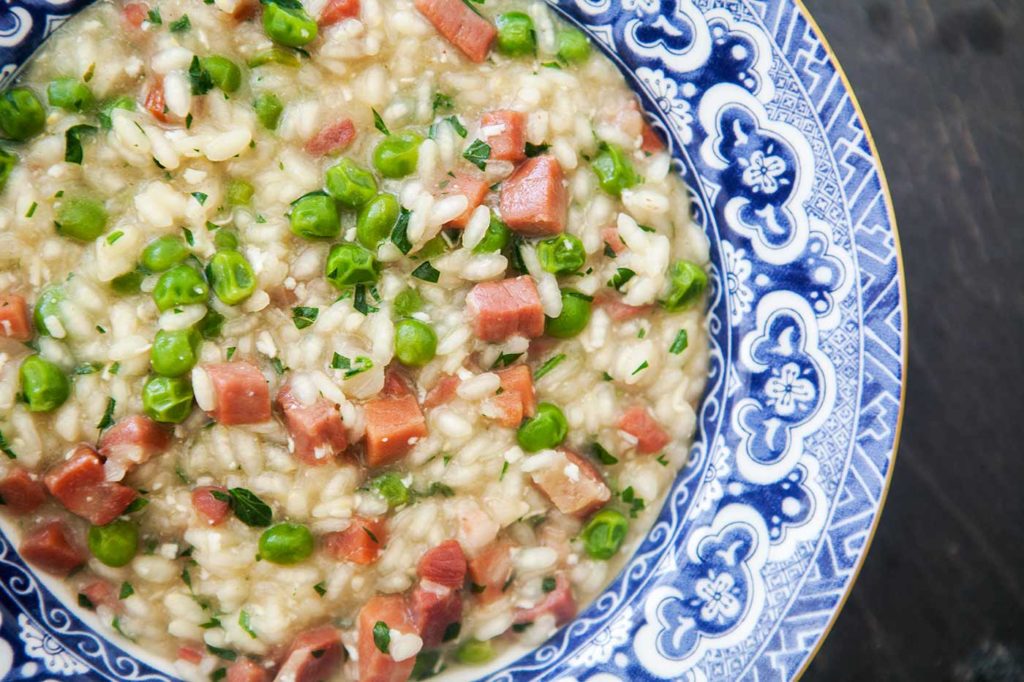The main dish risi e bisi (which should be translated as rice and peas, but which is actually much more) is a typical dish of the city of Venice and Veneto itself. Since forever, it used to be prepared in the spring, especially on the occasion of April 25th , day that in the “Serena Repubblica” of Venice has always been synonymous with celebration, since it is the day of the patron saint of the city, San Marco. It was served to the Doge as a main course and he had to strictly be the first person in the city to eat it. Nowadays, the tradition in its preparation is the same but it has become a much poorer and more accessible dish, perfect to be included in the daily diet just like any risotto.
Risi and Bisi (literally “Rice and Peas”) is the most famous recipe of the Venetian culinary tradition and is a dish that recalls a risotto in all respects. Obviously, the dish, although not complicated to prepare is not even that simple, and requires more than just the use of rice and peas. There is also pancetta, parsley, parmesan and onion, and a particular method of preparation. It is a simple recipe and there are not many variations.
Unlike many famous Italian pasta dishes, risi e bisi is a dish whose basic recipe has remained almost unchanged over the years. Very important in this case is the choice of rice, which must be a good quality Vialone nano.
The Vialone nano is typical of the Verona area. It is an all round kind of rice, and can be used for many types of different dishes. It is not too sticky, it lends itself well to risottos as well as to recipes in which a more grainy rice is required. It is a medium grain rice, semi-long and oval.
Origins of the risi and bisi dish

The risi e bisi first course was born in Venice and spread very slowly, as the “Serenissima” took over new territories, even to the Vicenza area. Little by little it has become the typical recipe par excellence of the Venetian lands, where it is prepared all year round but with a marked preference for the spring period. The official recipe in fact sees the use of the first pods of freshly harvested peas (which can be easily found, in fact, in spring). The whole of the peas is used, including the skins that are thrown into the cooking water to make the stock that is the basis of the dish.
It was the dish that was served to the Doge of Venice on the occasion of April 25th, day dedicated to the celebrations for San Marco, patron of the city. The dish, now considered “poor”, was at the time a real privilege for the very few, because it is rich in vegetables and made with a fine rice, fairly costly ingredients at the time. Legend has it that there was precisely one pea for each grain of rice.
The risi and bisi recipe: the broth
Before preparing risi and bisi you need to make the vegetable stock. To make it you will have to stick to the traditional broth recipe (or use a stock cube) but with a slight difference.
In fact you will have to boil the empty pods for about 20 minutes with a little water. Once they are soft, you will blend everything with an immersion blender and add the puree obtained to the freshly prepared broth. Therefore for the success of the recipe, it is necessary to use fresh whole peas, still to be shelled.
Risi and Bisi: the recipe
To prepare a good plate of risi and bisi for about 3 people, you will need:
- 250g of peas
- 180g of Vialone Nano rice
- 40g of butter
- ½ onion
- 10ml of EVO Oil
- About a litre of vegetable broth (as just suggested)
- 50g of pancetta
- 40g of Parmigiano Reggiano
- Parsley q.b.
Finely chop the onion and parsley. Cut the bacon into cubes. Put everything to brown in a saucepan containing the hot oil and half of the butter. Be careful not to burn anything. Once the sauté is ready (and the onion is golden), pour the peas into the saucepan, lower the flame and cook for about ten minutes, stirring often. Finally add the stock until it just covers. Bring to a boil.
Once it has reached the boil, add the rice, stirring constantly so as not to let it stick. Cook everything as if it were a risotto, continuing to stir and adding the broth gradually, only if necessary.
When cooked, add salt and mix well with the parmesan and remaining butter. Leave the rice and peas to rest for one or two minutes and serve still warm.

